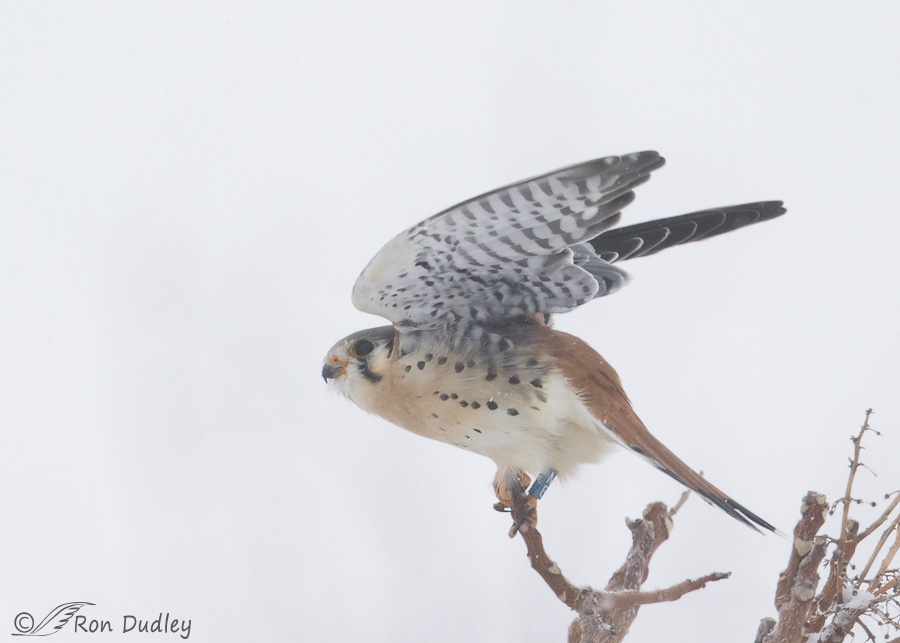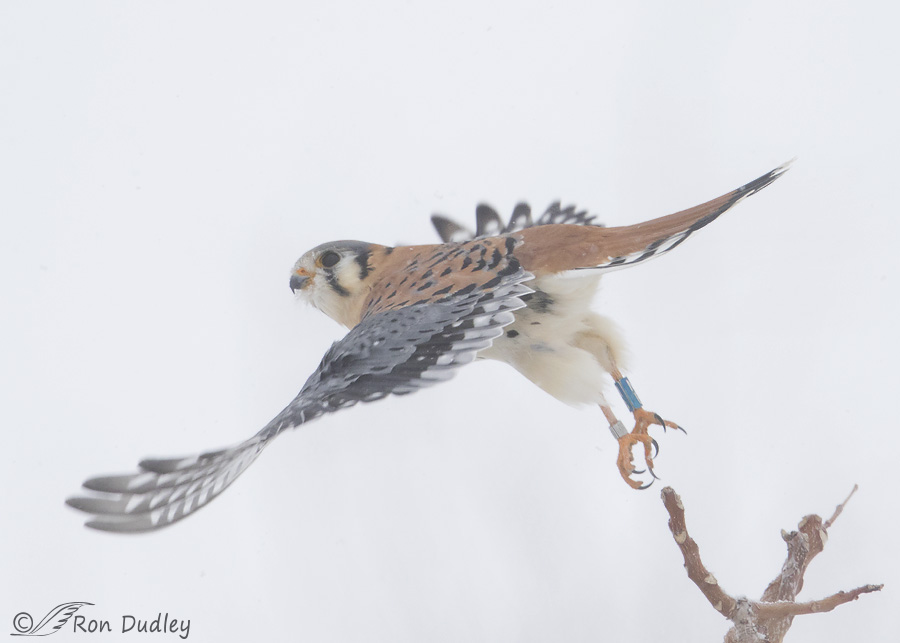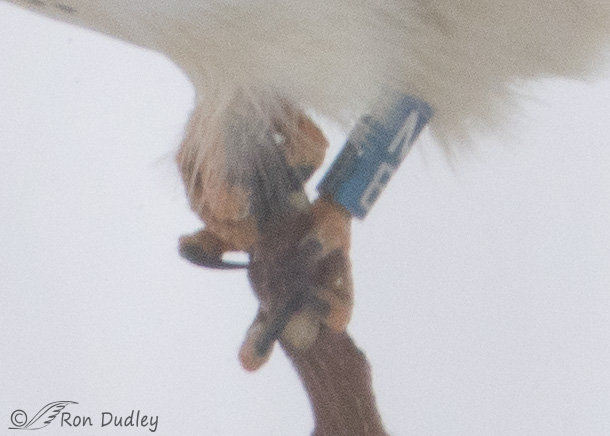As promised, here’s what I now know about the banded male American Kestrel I photographed on Christmas morning.
But first a little background for those who didn’t see yesterday’s blog post.

1/2500, f/6.3, ISO 800, Canon EF 500mm f/4L IS II USM + EF 1.4 III Extender, not baited, set up or called in
I found the bird perched near the north boundary of Farmington Bay WMA in terrible conditions for photography (it was foggy, snowing and fairly dark) but I took a few photos of him anyway. While perched he was scrunched down on the branch so I couldn’t see that he was banded but as he took off his “jewelry” became apparent.

1/2500, f/6.3, ISO 800, Canon EF 500mm f/4L IS II USM + EF 1.4 III Extender, not baited, set up or called in
He was actually banded on both legs.

A huge crop of the first image above revealed parts of two large white letters on the blue band (on his right leg though in this photo it looks like it might be on his left) that I thought might be an N and a B or an N and an E and because I was familiar with HawkWatch International’s American Kestrel Study I suspected it might be their band. HWI’s headquarters is right here in Salt Lake City and several of those folks are personal friends of mine so I contacted Board of Trustee member Mike Shaw to see if my photos and info on this bird were of any interest to their kestrel study. They were.
Mike generously shared with me what he knew about this bird. With his permission I’ve quoted him below (I’ve added clarifications within parentheses).
- “Pretty sure it’s M over B (the letters on the blue band), as we haven’t deployed any blues with “N” as the top character, and M over E was put on the left leg of a male nestling from a nest box at the top of 4500 S. and I-215 (in Salt Lake City). We put color on the left leg of known nestlings and the right leg of those presumed to be adults.”
- “Assuming M over B, this guy was caught and banded on 1/22/16 at the entrance to the Nature Center at FB (Farmington Bay). He was at least a second year bird at that time, so as of 1/1/17 he’ll officially be at least a third year bird and an assumed breeder. There’s 2 active nest boxes in that close proximity and I’m curious if that bird is staying on territory all year, or if he’s a winter resident. Suspect the former. We’re starting to see some very interesting dispersal and survivorship patterns. Not much is known about kestrel survivorship in the wild and the extensive color banding we’ve done, as much as I dislike it, is starting to yield some great data in that regard.”
To put this in perspective the Nature Center where this bird was banded last January is perhaps half a mile west of where I photographed him 11 months later.
I appreciate this information from Mike immensely. I always report banded birds when I can because that kind of research information can be of value to the conservation of the species but to be honest I also do it because I find it so interesting when I get feedback on the history of the bird. Knowing that kind of information about an individual bird doesn’t happen very often but when it does it kind of makes my relationship with that bird a personal one. And I like that…
The work of HWI is terribly important to raptors and to all of us. Their mission is “to conserve our environment through education, long-term monitoring, and scientific research on raptors as indicators of ecosystem health.”
I support HWI at every opportunity and I encourage others to do the same, with them or with other like-minded organizations. Collectively I’m convinced we can make a positive difference.
Ron


Good for you to get I.D.Wouldn’t it be something to spot this one again as one of a nesting pair with their fledges?
I’ll be keeping an eye out, Jane. You can count on that!
Thank you for sharing your friend’s input. That is very interesting. I hope you see the bird again, and with a female. What a thrill that would be. Keep your peepers open!
Happy New Year everyone!
Peepers perpetually open, Jean!
Really interesting info!
And I know you probably won’t believe me , but I honestly considered that what I had commented was likely an N on yesterday’s post was an M. I don’t know much about banding though, and I thought that maybe kestrels are only marked with N’s. Looking back, that makes absolutely no sense, but I have next to no knowledge of banding procedures, and I didn’t want my lack of knowledge to show. An odd thing to comment, maybe…
Oh I believe you, Levi. I was waffling back and forth myself. Thanks.
Hooray for survivors. Plucky, determined survivors. And for everyone who helps.
And hiss and spit to the hinderers.
I have wanted to band birds that we rehab. It would be interesting to follow to see where they went and hopefully survived their second chance. I don’t think most rehabers want to, if it showed low survival rate it would give more power to those in control who feel rehabbing is a waste of money and time and does nothing to save species.
April, I’m wondering if there may also be other reasons why at least some rehabbers are reluctant to band. Many rehabbers I’m aware of are very concerned about the welfare of the individual birds they’ve worked with after they’re released and bands can sometimes be a serious nuisance to birds and occasionally even worse than that…
Agreed, I hate bands on birds, but sometimes for scientific info they are invaluable. I have removed even our pet parrots band but keep them for the info on the bird.
April, I think your summation is right on target. It very well might be true that rehabbing doesn’t impact wild populations in any way, HOWEVER, I believe that a) it can’t hurt and b) is makes a HUGE difference to the individual critter being rehabbed/released. AND if they survive long enough to raise a family that adds to the population (with all the obstacles to survival we provide), then it’s GOOD!
I’m hoping to get back to rehabbing as soon as I get settled here in Arizona. I always treasured my volunteer/education/rehab time, regarding it as a giveback to the privilege of sharing my life with “my” birds (who are no more mine than the air I breathe!). That time was precious to me.
Laura, I have always been a proponent of the Starfish Story. I am also big on Horton Hears a Who.
These are absolutely breathtaking pictures you got! I love it! It captures the fierceness and freedom of these creatures which I think are so beautiful. These kind of article will be such a great help to raise awareness and promote the beauty of photography in natures and the creatures that lies within. I know that taking these type of photos might be stressful and challenging and would take a lot or patience and persistence but you definitely did a exemplary job! These photos should be on magazines and newspapers! Amazing job!
Thanks very much, Jaypee
Check out the chart…
Ok, now I get it. Thanks for clarifying, Patty. The only thing I could figure is that you were talking about the colors on the bird and if so I couldn’t figure out why you would say it. Sometimes I can be kinda dense…
You sure were!!!!!!
That’scan awful lot of red and orange!!! The red is especially shocking…
?…
Talking about the chart and the decline in kestrel populations…my falconer frirnd, Jim, is VERY,VERY concerned!!!
I know I’m very, VERY concerned too, Patty! It was such a joy to see multiple Kestrels in and around the Kingman, AZ area along with those I saw at Pat’s house in Phoenix. But that they’re struggling in so much of their range is frightening!
Kestrels are AMAZING! They’re fierce, brave, determined and overall annoying buttheads (in a GOOD way, of course…LOL!)! We cannot allow this kind of decline in populations!
Thanks so much for that update, Ron! What a delight to know that this guy is a survivor and that he’ll be making more Kestrels soon! Color me jumping up and down, doing the Snoopy Dog Dance!
There are a lot of folks who believe that monitoring (through banding and other methods), studying and rehab make absolutely no difference to wild populations. I couldn’t disagree more strenuously! My blatantly obvious case in point–the recovery of peregrines and bald eagles. There’s so MUCH we don’t know about what happens in our (greater) world that it’s just ridiculous–and that despite we believe that we know it all. But once again, here I am preaching to the choir
Thank you is so inadequate for what’s in my heart on a daily basis, but it’s the best I can do. THANK YOU!
Knowing how much you love kestrels I figured you’d enjoy seeing this update, Laura. Thank you.
Wonderful post Ron, many thanks.
As a past bander I am curious why Mike “extensive color banding we’ve done, as much as I dislike it” dislikes color banding when it provides good research data?
Dick, he may not have been referring to “color banding” in particular, but to banding in general.
Like many of us Mike has mixed feelings about banding. In past conversations he’s told me that he isn’t fond of the stress the banding process puts on birds and he also believes that some banding is done for studies that aren’t well designed so the results sometimes aren’t very useful, if at all. In the past some banding has also been done largely just because it’s “sexy” in some circles – particularly with raptor banding.
I also suspect he isn’t fond of seeing jewelry (some refer to bands as “leg irons”) on otherwise wild and free birds. If so, that’s a view I share.
That said, Mike obviously feels that banding, when properly done by trained individuals and for well-designed studies, is something he supports. And I concur.
Of course I can’t speak for Mike so I hope I’ve paraphrased how he feels on the subject as accurately as possible. I may not have…
Thanks, all good points, although I have not seen or been involved in those unsupported banding activities.
My banding was done for educational purposes as well as a long range study on a Roseate and Common Tern population.
I’m glad you were able to get information on this beautiful guy. I checked out the link, and saw that Kestrel status is questionable in my area. I wish I knew what happened to the pair that nested in our neighbors’ tree for two years. They were such a joy to have around, and my husband and I both miss them greatly. I join in on hoping this guy is able to raise many successful offspring.
Susan, I’ve heard from so many folks that they think they’re noticing significant declines in kestrel numbers in their areas. It’s very disturbing.
Outstanding effort, Ron! Through your photography and excellent documentation, I feel as if I’m riding shotgun right along with you. Keep up the great work!….Mitch
Happy to have you along, Mitch. At times that “shotgun” of yours would be very useful and I don’t mean for use on birds…
Thanks for the update Ron! I hope you had a wonderful Christmas and I wish you the very best New Year!
Thank you, Sharon. I did have a nice Christmas but to be honest I’ll be happy to get the holiday season behind me.
The reason it’s so important to report Kestrel sightings: http://kestrel.peregrinefund.org/index.php?action=decline
Thanks very much for the link, WC.
I encourage all readers who love birds, and kestrels particularly, to follow this link for a little dose of reality.
Nice. Love that information. Hope this bird helps its species.
Thanks, Arwen. Me too.
That was fun Ron, thanks for the update. As you said, having that background on the bird adds some familiarity of who he is and what he has been up to since he got banded. That familiarity creates a little personal bond that otherwise doesn’t exist. Funny how we humans think. I’m sure the Kestrel would not reciprocate that emotional tie.
I was just noticing your TAGS and Category section. I commend you on your organizational skills. It reminds me of a “key”.
“That familiarity creates a little personal bond that otherwise doesn’t exist”
Exactly, Frank. Well said.
Thanks for the compliment on my “organizational skills” but don’t look too closely very often. I’m afraid that in the rush of getting a post published on mornings when I can go shooting I fall down in that regard fairly often.
Fascinating! Thank you Ron for playing sleuth on this one and thank you Mike for the info on this guy. Hopefully, this bird will be a proud papa before too long!
And Ron, these are some pretty great shots for “terrible conditions!”
Thanks, Marty. I did what I could in those conditions.
I too wish for your “proud papa” scenario.
The nest boxes made me think of the eagle cams. DC isn’t up yet, but I was able to see the video of Romeo and Juliet’s two nestlings hatch and watch the nest for a while. Definitely put a big silly grin on my face!
Interesting! Thx for the information, Ron. Now you’ll be looking for him again.
Now you’ll be looking for him again.  Wind howling this morning…………:(
Wind howling this morning…………:(
I sure will be looking for him again, Judy! And for other kestrels in the area that HWI has banded. That means that I’ll be scoping birds with my lens that I might previously have ignored.
“Howling wind” in Montana! Nah, couldn’t be – never heard of such a thing…